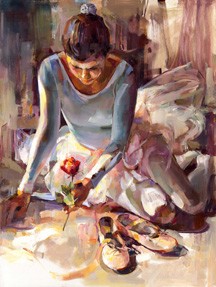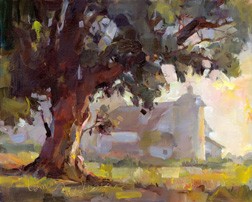Q&A: Questions & Artists – Tom Nachreiner
- Share
- Tweet
- Pin
- Share
This is part two of my interview with Tom Nachreiner. His work can be seen at Edgewood Orchard Galleries in Fish Creek.
Randy Rasmussen (RR): The biggest response I have had in doing interviews of artists for more than four years was the interview we did with you three years ago. Why do you think your work resonates with people so well?

“The Rose” by Tom Nachreiner.
Tom Nachreiner (TN): What a compliment! I am overwhelmed with the question because I aim high to try to accomplish just that. I would like to say, people see the years of experience, the craftsmanship of drawing and the controlled looseness in my work. But, truth be told, I just count my blessings for my success and the relatively recent following I have acquired in Door County.
I owe it all to the call I got from Cinnamon Rossman to invite me to paint in the first 2006 Door County Plein Air Festival, and in the following year, putting in an encouraging word at Edgewood Orchard Galleries for them to represent me. Between the Peninsula School of Art director and staff, and the gallery with their fine staff and owners, I’m in really good hands of getting exposure. I also have to mention my good friend Randy Rasmussen, who believes in me, as well as so many Door County friends and patrons that have helped build my name and reputation by word of mouth and by sharing their private painting collections with others. Through my newsletter, workshops, shows and my yearly demo at Edgewood, I continue to reach more and more people in Door County. People have come to know Nancy and I and have seen how dedicated I am, but also how much I enjoy painting. I’m so privileged and so thankful. I’m so lucky to have had Nancy’s support through all my endeavors.
RR: Can you elaborate with specifics of why you think people relate so well to your paintings?
TN: I’m still traditional in the overall approach to my paintings, but what makes me slightly different than other traditional artists might be found in the four most important factors I have worked toward, as my personal goal, all my professional life as an artist, since art school, and am still continuing to try to improve on. They are: strong accurate drawing with character; composition/abstract design; a fluid confident spontaneity; and a burning desire to experiment and to become better. I remember what Sorolla said, “Approach every painting as a sketch.” That’s why plein air painting is so important to me. I try to make my paintings less about detail and subject matter, and more about the light, mood and design. I try to keep all of my paintings looking as though they were done plein air, like a sketch. I hope they look effortless and fresh.
The other thing I have heard from others about my work, that maybe makes me a bit different, is that they often experience two paintings in one in some of my work. “One painting you get from a distance where everything falls together, but draws you in, and then, close up, you get a completely different, more abstract painting, that you can kinda get lost in.” You know, I do things intuitively and I probably would just call that “Impressionism.”
Also important, I can’t rule out my past experience as a professional artist in advertising, which gave me an understanding of marketing art to the masses, now an intuitive part of me. Since those days, I have always done every painting as though it is for my own home, for me. And what I want in my home is less about detail and subject matter, and more about the light, mood and design. So I figure if I would want it in my home, maybe others will like it too.
RR: Is there somewhere in Door County that you have heard about and want to paint in 2015? ( I will try to facilitate this.)

“Foggy Farm” by Tom Nachreiner.
TN: I am always looking for a new area, a new view, and new subject matter. I haven’t seen it all yet. Please continue to tell me about such locations, like the places we paint at in my spring workshops. I’m always interested in the history of Door County, with its lighthouses, marinas, working fishermen, working fishing boats, working tugs, the natural beauty of rock formations and bluffs, the beauty of the water, as well as the inland beauty of the farms, trees and fields.
RR: Was there a slight change in your work done in the Cedarburg Plein Air Event this year? It had a fresh feel to me when I viewed your paintings.
TN: I got many similar comments and some questions from other artists there about just that. (I use Cedarburg’s 10-day event to “tune up” and to get “momentum” for the Door County Plein Air Festival a month later.) I changed several things that seem to work better for me and are more natural to me, that are all related to my past watercolors done before 2003:
1. I had to sit this year, because of a sore knee I developed in spring, which slowed my painting process down a bit. I was able to be more comfortable, more relaxed and took my time a bit more. Therefore I needed to make up that time, especially in the quick paint. It forced me to be more efficient with my brush stokes and make every one count, draw more carefully and accurately, like I had to do when I worked exclusively in an unforgiving watercolor years before, both studio and plein air.
2. I used to separate my watercolor of the past with my oil of today. This year I didn’t so much. I am who I am and I just let it go this year. I even took it further and did a continuous line drawing when I started; in this case with a pastel pencil, which I don’t let leave the surface, while drawing positive shapes connected to negative shapes, all adding up to a planned design. I have the line go off the canvas on at least three sides for a better composition. As I continued my “more watercolor like” approach I strived for a wetter beginning too, and on a white surface, retaining some whites just like in watercolor, giving a fresher, cleaner look. Also, like in watercolor, being more careful with the darks, and more careful drawing with my one brush, and not using a small brush at all.
3. Finally, all the way through, I looked for, and tried in my own way, to get some of the spontaneous, happy accidents I used to get in watercolor and have missed in working with oils. I hope I can refine this more fluid approach in the future like I can see it in my mind. This was a start.
Thanks for all the questions, they are thought provoking.
To learn more about Nachreiner and his work, visit tomnachreiner.com.
